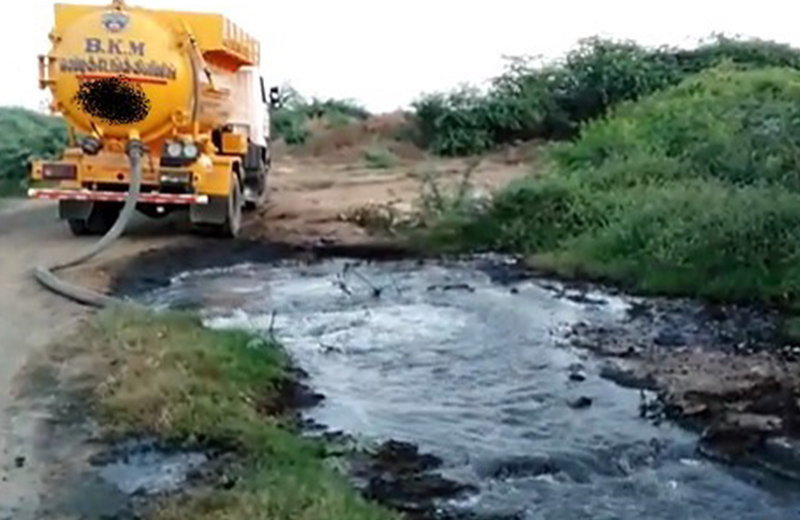As a child back in the village, I had always cherished the sight of clear water running below bridges. But moving to the city, the car windows are always drawn up and the car zooms across bridges in a bid to avoid the stench emanating from the river. This begs the question, why are we in urban India so deprived of a clean environment?
We live in an age where adequate importance is being given to toilets. However, what happens after one uses the toilet? Where does it all go? Ideally the toilets are either connected to the underground sewer (off-site sanitation system) or a pit latrines or septic tanks (on-site sanitation system) from which the waste is taken to the sewage/septage treatment plants. Does this really happen?
rban India with a whopping population of 377 million sends out only 30% of the sewage/sepatge from its toilets to the treatment plants. An analysis by Indiaspend says that the remaining three-fourths of the sewage/septage is illegally dumped into our lakes, rivers and seas polluting our water bodies. So why is this rampant pollution of our environment being ignored? Is it the lack of legal instruments and monitoring mechanisms to control the pollution, or is it the poor implementation of existing laws?
To start with, let us look at the laws which are in place for safe containment, collection and transportation of fecal sludge.
- Tamil Nadu District Municipalities Act, 1920 (applies to the 124 Municipalities and 528 Town Panchayats in the state)
- 12 Municipal Corporation Acts enacted for the 12 Municipal Corporations in the State.
- Tamil Nadu Public Health Act, 1939.
- Various bye-laws at the State and Urban Local Body level.
The TN District Municipalities Act, 1920 and 12 Municipal Corporation Acts has rules and bye-laws in place for construction, operation and maintenance of toilets, sewer systems and septic tanks. The Tamil Nadu Public Health Act, 1939, is a significant Act which exercises rules for prevention of sewage/septage from containment systems or insanitary toilets to be let out into open spaces or water bodies, prohibits practices of open defecation, and further issues directions for closure of unfit containment systems/insanitary toilets violating the laws. With respect to Toilets and On-site systems, there are Acts which enforce safe regulation. In any case, despite existence these legal instruments a deeper question arises with respect to implementation of these laws.
The enforcement of many of these rules do not hold good at the field-level due to practical difficulties involved in identifying insanitary toilets and retrofitting them. The minimal fines starting from Rs. 30 to be imposed for violation of laws are seldom put into practice. In terms of collection/desludging, the CPHEEO Manual on Sewerage and Treatment, 2013 advises regular de-sludging of septic tanks. The Prohibition of Employment as Manual Scavengers and their Rehabilitation Act, 2013 recommends the usage of mechanical devices and safety gears for deslugding.
A further look at the transport and emptying of fecal sludge component denotes neglect with respect to legal structures. Although the Act says that only authorised vehicles/carts with adequate covers and licenses are allowed to collect fecal sludge from households; regulatory practices for checking on their safe disposal seem to be absent. Particularly, there is an absence of any designated monitoring authority to prevent disposal of fecal sludge into the water bodies/open lands. As a result of these gaps there is a rise in the unregulated private sector operating under unsatisfactory conditions causing harm to the environment and public health.
While there are gaps existing in the current legal instruments which need to be plugged, the bigger issue, however, is the poor implementation mechanisms. These can be attributed to fragmented laws, lack of awareness on the negative impacts of improper sanitation and inadequate number of existing sanitary personnel solely dedicated to implementing sanitary works.
Therefore, it is necessary that the Central government and Tamil Nadu State government which are now in the process of seriously implementing the National Policy on Fecal Sludge Management and Operative Guidelines for Septage Management for Urban and Rural local bodies in Tamil Nadu, 2014 respectively, should work towards creating awareness among all stakeholders which will go a long way in the implementation of these policies/guidelines.
References:
Tamil Nadu District Municipalities Act. 1920. “Tamil Nadu District Municipalities Act.” Tamil Nadu: Government of Tamil Nadu.
Public Health Act. 1939. “Tamil Nadu Public Health Act.” Tamil Nadu: Government of Tamil Nadu.
https://thewire.in/20320/70-of-urban-indias-sewage-is-untreated/

Srinithi Sudhakar
Senior Associate, TNUSSP


Leave A Comment
You must be logged in to post a comment.